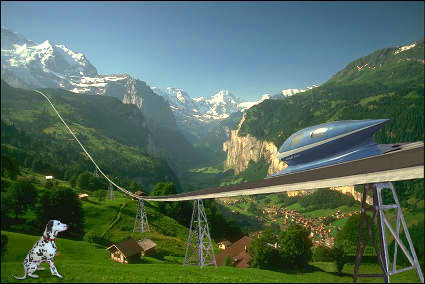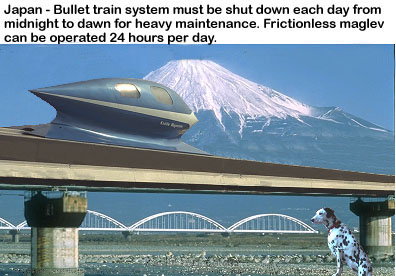The Knolle Magnetrans System
The Knolle Magnetrans system is an endless continuous passenger transit system having small cars moving along a fixed guideway. Embedded in the guideway is a tubular prime mover performing the same function as a cable in a cable-car system. The prime mover is driven by widely spaced stationary linear induction motors. The passenger cars are attached to the prime mover at fixed intervals and are pulled along by it. The wheelless cars are suspended magnetically over the track with permanent magnets in repulsion. The prime mover physically manipulates the cars to come to a crawl in stations. Passengers board dynamically from juxtaposed moving platforms. The basic mechanism is covered by U.S. Patent No. 3,320,903, Re 26,676; held by Ernst G. Knolle, inventor. A full-scale prototype vehicle and short test track has been built.
According to the inventor, the vehicle contains no power equipment or controls, it uses no energy to levitate and banks over 45 degrees in turns. It can climb steep grades, use existing bridges and would not disturb neighborhoods to go in and out of cities. It is easy to operate and mass produce and can go as fast as 200 mph.
The vehicle would be fabricated with aircraft-like construction, would weigh about 300 pounds, be 12 feet long and 3 feet, 3 inches high. The aerodynamics would be nearly perfect (Cd of about 0.04) and it should require about 10 horsepower at 200 mph. The flat bottom would be covered with 32 rows of permanent magnets which would cause the vehicle to levitate above the track. The frontal area is reinforced with no window as protection against collisions with birds and debris. A small linear induction generator would provide power for hotel functions. In mass production, possibly using fiber glass and plastics, the price of the vehicles would be less than $3,000.
The advantages of using permanent magnets in repulsion to levitate the vehicles are that:
- No energy is required to achieve lift forces
- The magnets are abundantly available at low cost
- The magnets are easily installed
- The magnets hold their lifting power virtually forever
- Virtually no maintenance is required
- The magnets are safe to operate, and
- Because the magnets are made of insulating material, there are no drag forces resulting from eddy currents.
The vehicles are permanently attached to a continuously moving, endless, long-linked chain. Chain guide rails along the track are used to guide the chain stretched out between stations, but force it to fold up in stations. This folding causes the chain and vehicles to slow down and come together in stations (see drawing of chain folding concept ). Passengers board from a moving platform which run beside the vehicles. The vehicles are flat-bottomed that are covered with longitudinal rows of permanent magnets that repel themselves above identical magnets on the track. The speed differential between the line speed and station speed is determined by the length of the chain links. If the links are 18 feet long, the system could run at 200 mph between stations and at escalator speed in stations.
Plans, cost estimates and a feasibility study have been made (1) for a 5-mile oval test track, (2) for a 5-mile 10-station loop for the 1998 City of Irvine (California) Guideway Demonstration Project, (3) for a 30-mile 30-station dual track in 2000 for the Centerline Project by the Orange County (California) Transportation Authority and (4) a 21-mile 20-station loop in 2001 for the Austin City (Texas) Transit Project.


Patents and Papers:
1. Obtained U.S. Patent 6, 301,736 for "Elevated Suspended Guideway", 2001
2. Obtained U.S. Patent 6,122,578 for "Active Controls for Vehicular Suspensions", 9/19/00
3. Knolle, E.; Articulated Train System, U.S. Patent No. 3,320,903, Re. 26673, 1969.
4. Knolle, E.; Bulk Material Conveyor, U.S. Patent No. 4,024,947, 1977.
5. Knolle, E., Knolle Magnetrans High Speed Maglev People Mover, Automated People Movers II, edited by M.V.A. Bondada, W.J. Sproule and E.S. Neumann, American Society of Civil Engineers, Library of Congress Catalog Card No: 89-17833, ISBN 0-87262-73.1-4, pp. 871-880, 1989.
6. Knolle, E.; Knolle Magnetrans, a Magnetically Levitated Train System, NASA Conference Publication 3152, Langley Research Center, pp. 907-918, 1991.
7. Knolle, E. Knolle Magnetrans: A Magnetically Levitated Train System, Library of Congress Catalog Card No: 93-11163, ISBN 0-87262-927-9, pp 760-770, 1993.
8. Knolle, E.; Maglev Crude Oil Pipeline, NASA Conference Publication 3247, Langley Research Center, pp. 671-684, 1993. (copy of this paper)
9. Knolle, E.; Bright Future for Languishing Maglev Technology, International Conference on Speedup Technology of Railway and Maglev Vehicles, Japan Society of Mechanical Engineers, Yokohama, Japan, 1993.
10. "Elimination of Bouncing, Weaving, Pitching in High Speed Passenger Transit Systems", Active Control in Mechanical Engineering, 2nd International Conference, Journal of Vibration and Control, 1997, Lyon, France
11. "Maglev Pipeline to Improve Grain Shipments from America to Asia, NASA Conference Publication NASA/CP-1998-207654, pp 199-200, 4th International Symposium on Magnetic Suspension Technology, Gifu, Japan.
12. "Magnetic Pipeline for Coal and Oil", Fuel Transport and Handling, POWER-GEN International 1997, Dallas, TX http://www.pennwell.com
13. Maglev Technology - Critical Review" Hypersonic Maglev Group/NASA Workshop, Langley Research Center, Virginia, USA, 1998
14. "Computerized Anti-Rocking Motion Attachment for Trains", MOVIC '98, Zurich, Switzerland
15. "High Speed Low Cost Maglev APM, Conference on Automated Peoplemovers 1999, Copenhagen, Denmark,
More details can be obtained by contacting Ernst G. Knolle , Maglev Scientist, 2961 Sean Court, South San Francisco, CA 94080; Ph: 650-871-9816. He is a licensed Professional Engineer in the State of California (Lic. No. 12372) and United Europe. More details on various application concepts are available at the Magnetrans website
or Return to Maglev Quicklinks page
Last modified: February 04, 2011